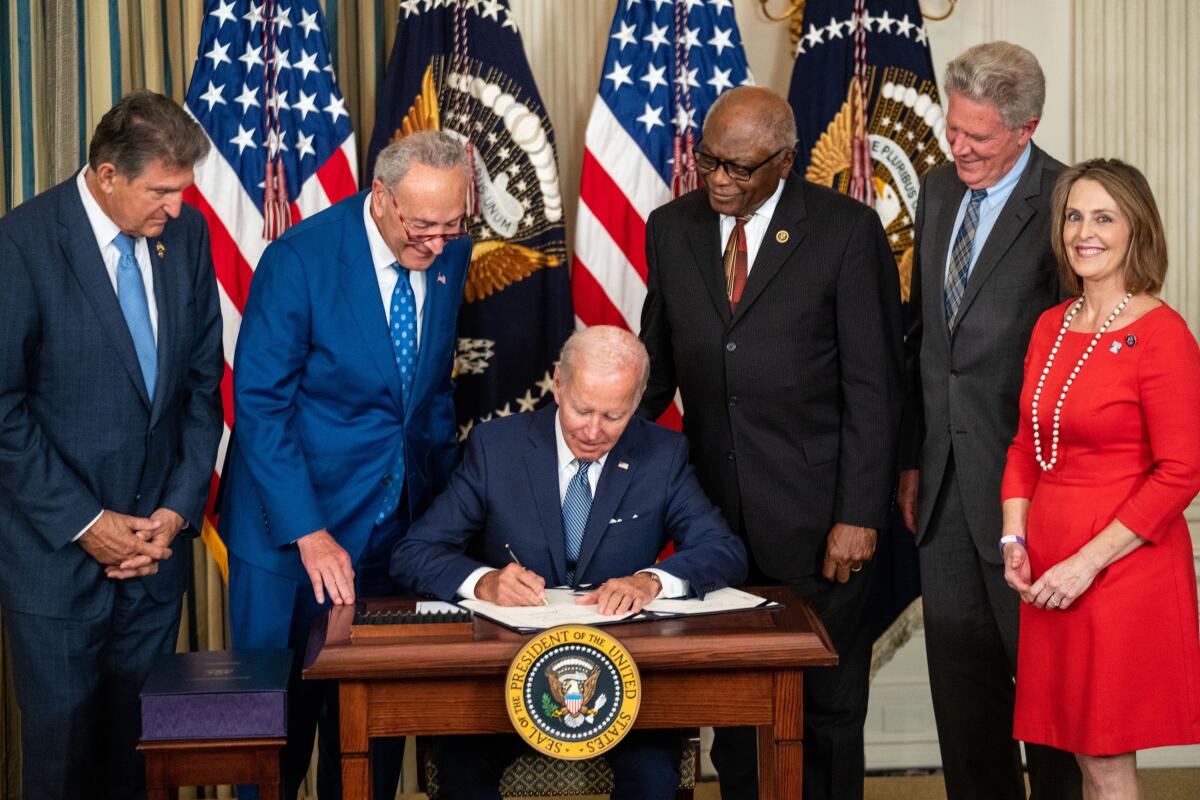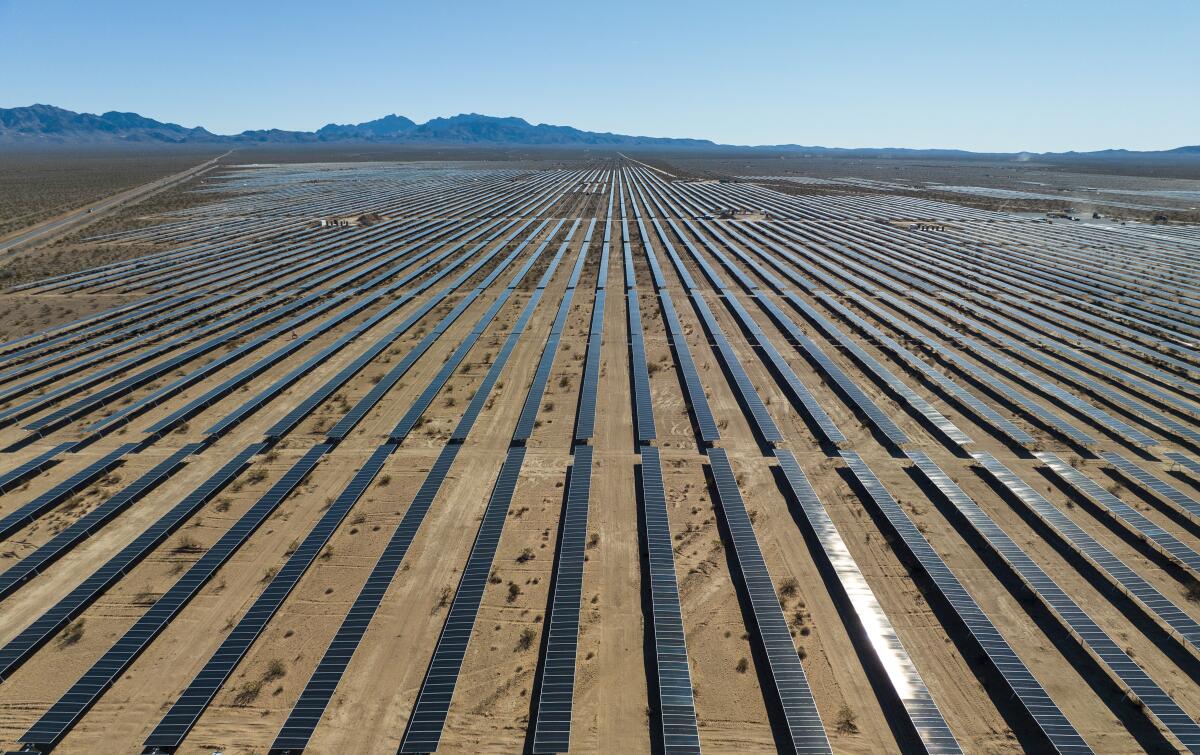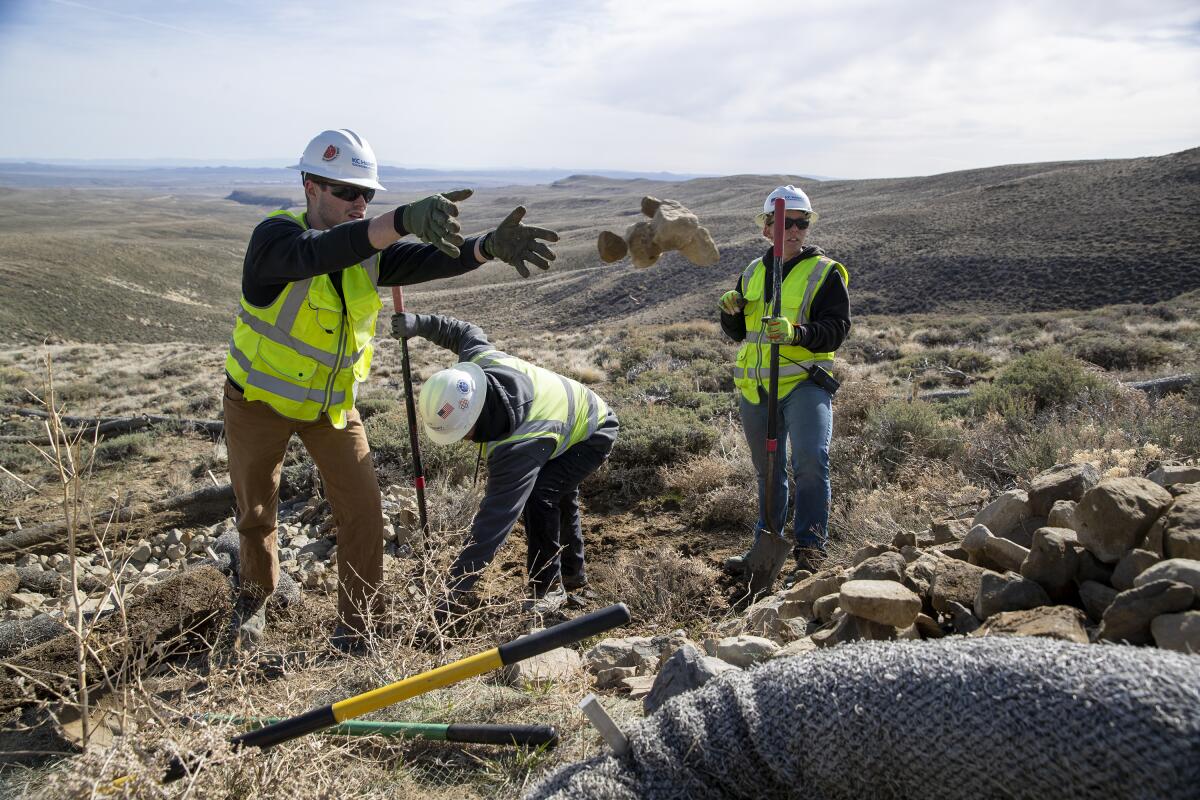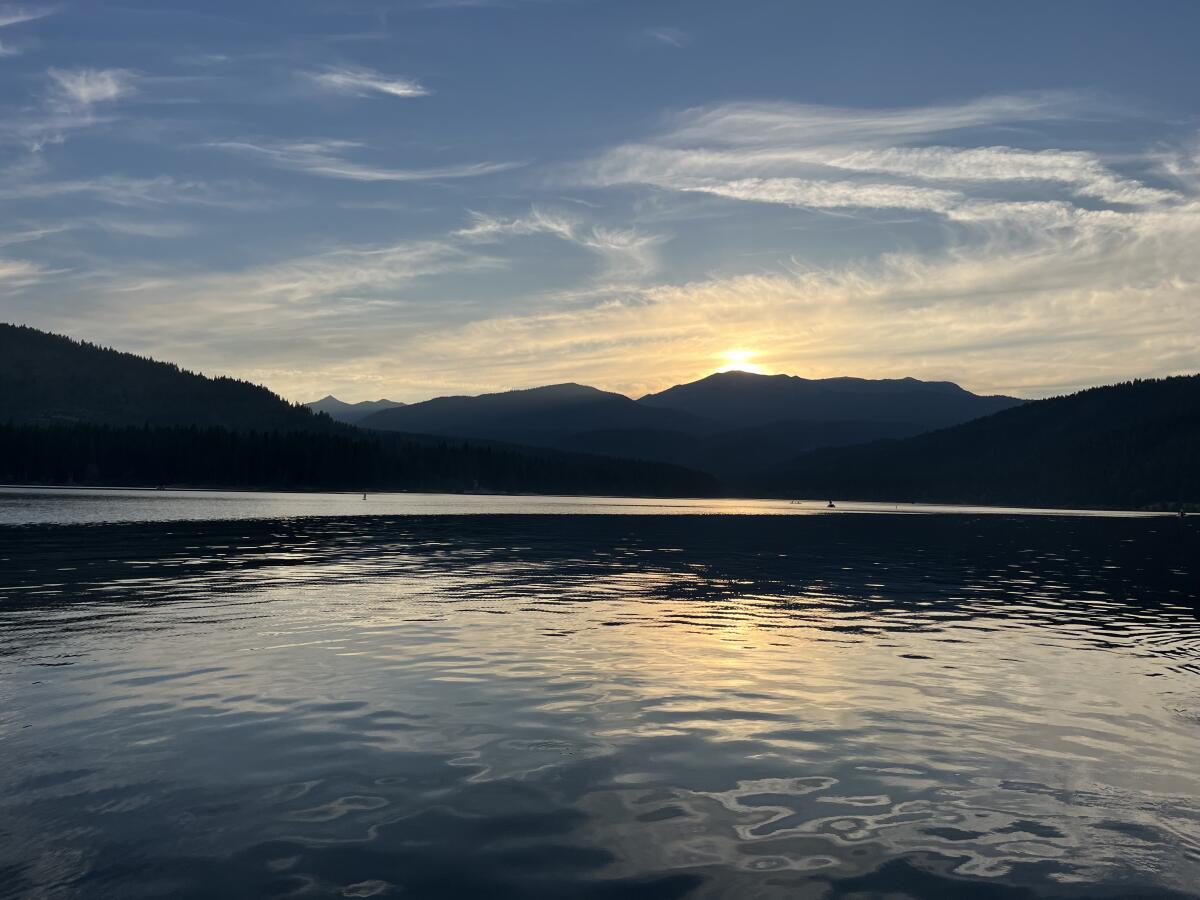The U.S. climate movement may be in trouble. Here’s why

- Share via
This story was originally published in Boiling Point, a newsletter about climate change and the environment. Sign up here to get it in your inbox.
The American climate movement may be careening toward a breaking point.
Sure, last year’s passage of the Inflation Reduction Act — which included $370 billion in clean energy and climate investments — was the first time Congress had taken major action on global warming. But the sweeping law also widened existing rifts within the nation’s climate coalition — rifts that threaten to derail the additional progress we still badly need.
That’s according to Josh Lappen, an energy historian currently completing his doctorate at the University of Oxford. He worries that a simmering battle over permitting reform — which reared its head during recent debt-ceiling negotiations in Congress — could “split the climate coalition into separate camps with irreconcilable theories of climate action.”
“The result, though ideologically purifying, would be politically disastrous,” Lappen wrote in a recent piece for Heatmap.
The permitting battle was central to the debt-ceiling debate, which ended with President Biden signing off on changes to federal environmental laws that could help both fossil fuel and renewable energy companies get their projects approved.
But the battle is far from over, with the renewable energy industry and a subset of climate advocates whom Lappen dubs “green growthers” lobbying for further changes that would make it easier and faster to build solar farms, wind turbines and other climate-friendly power projects. Even if those permitting changes also benefit fossil fuels, supporters say they’ll ultimately work out for the best because low-cost renewable energy will out-compete coal, oil and natural gas in the marketplace.
It’s a theory of progress that’s hotly contested by much of the traditional environmental movement, which has fought fossil fuels for decades and points to research showing the need to stop burning coal, oil and gas as quickly as possible — a shift that would not only slow rising temperatures but also improve air quality in many low-income communities of color.
Our best bet for limiting a future of increasingly deadly heat waves, fires, droughts and floods involves doing both — building huge amounts of renewable energy at unprecedented rates, while also ratcheting down fossil fuel production. How can we bring those goals together, especially given the potentially explosive politics? What are the political risks and opportunities?
I spoke with Lappen to get a deeper understanding of how he understands the challenges, and what solutions might look like. The following transcript of our conversation has been edited and condensed for clarity.

**
In your Heatmap piece, you say there are several fundamentally different ideas about how to slash heat-trapping carbon dioxide emissions. In a nutshell, what are those theories of decarbonization?
The different factions within the climate coalition have always had somewhat different theories about what decarbonization would have to look like. It’s only now, in part because of the great success of the Inflation Reduction Act, that the differences are becoming more salient than the commonalities. And that’s what’s driving the conflict.
The Inflation Reduction Act was advocated for by the entire climate coalition, but it was not a balanced representation of every faction’s opinions. It endorsed a theory that the best way to decarbonize is to rapidly and dramatically increase the supply of clean energy and then rely on market mechanisms to push fossil fuels out of energy markets. The question that the climate coalition is confronting now is whether to double down on that theory or to complement it with a different theory.
The leading alternative theory stems from major swaths of the environmental movement, which for a variety of historical reasons has been and remains focused on directly constraining and reducing the supply of fossil fuels.
It seems like a lot of the debate over permitting reform revolves around whether you think letting renewable energy and fossil fuels duke it out in the marketplace will lead to fossil fuel production falling quickly.
Right. The reason permitting reform has become so controversial is because it doubles down on the Inflation Reduction Act’s theory of decarbonization. Permitting reform doesn’t make any space for the alternative theory. It actually loosens restrictions on fossil energy production with the goal of accelerating clean energy production.
But the environmental movement, from 50 years of experience, believes that existing environmental laws are powerful tools for restricting fossil fuel production, and in fact some of the only tools they’ve been able to leverage with fairly consistent success. So permitting reform is asking the environmental movement to disarm, to weaken what it sees as its most effective climate tools, while also continuing a political trend of not taking its vision of how to decarbonize into account.
Is this debate just going to get more intense as the clean energy industry grows its political muscle, and as the climate crisis gets worse?
It definitely seems like it. Permitting reform has been a goal of industry-friendly Republicans since the environmental permitting processes were created. Now there’s also a wing of the climate coalition that sees it as important to the deployment of clean energy. And the clean energy industry itself has rapidly matured in a way that has brought its interests much more into alliance with the fossil fuel industry’s interests. That potential political alliance is quite powerful.

Do you think we still need traditional environmental groups to keep making progress on climate, now that there’s an alliance forming between renewable energy developers, green growthers and maybe even fossil fuel companies?
There’s a growing portion of the climate coalition that would say we no longer need the environmental movement. Part of the theory of the Inflation Reduction Act is that it will create an alternative mass political movement — that by bringing tons of clean energy jobs to all parts of the country, and especially to fossil fuel production areas and to red states, it will create a new industrial voter coalition that will allow for more climate progress with or without the environmental movement.
That’s the claim, anyway. I think there are several reasons to be skeptical.
For one thing, that new alliance doesn’t exist yet, and the environmental movement remains powerful in many parts of the country. I also think history should make us skeptical of the idea that you can buy your way into a mass political coalition by giving people jobs. People vote on a number of values, and their employment is just one of them.
The second reason the environmental movement isn’t dispensable is because it has a different theory of decarbonization than others in the climate coalition do. As we face a massive 50- to 100-year political effort to remake every system that modern industrial life is built upon, it seems very risky to double down this early on one political theory of change, especially as we head into difficult decades — what Emily Grubert and Sara Hastings-Simon call the “mid-transition,” where the climate crisis and energy transition will combine to destabilize energy systems and politics.
We need to be able to rely on as many different sources of political support as possible, as many different values and motivations as we can to maintain the political will for decarbonization when it gets really hard. Because it hasn’t gotten hard yet.
I’ve been writing a lot about the debate over different types of renewable energy — especially large-scale solar versus rooftop solar. I think that’s relevant to this conversation, where you have a divide between traditional environmentalists — many of whom favor small-scale solar within cities — and green growthers who are more inclined to support sprawling solar farms on public lands, even if there’s collateral damage to local ecosystems and wildlife.
I agree that it’s closely related. Land use is at the core of permitting reform. This is a conversation about how we should use our public lands, and which private companies we should allow to use our public lands, and for what.
Some people within the climate coalition have framed this debate as environmental protection — clean air, clean water, endangered species — versus reducing carbon emissions. But there is an alternate framing, which is that actually, these things are not opposed. And that when traditional environmental groups push back against certain types of clean energy development, or efforts to reduce the power of environmental laws, they’re not just trying to protect water, air, species — they’re actually pushing for decarbonization. There’s just this underlying disagreement about how to achieve it.
That’s the core of the problem right now — clean energy and decarbonization are no long synonymous. People have different opinions about how they should relate, and what we have to do to make sure that pursuing clean energy will actually lead us to decarbonization and not just to more energy overall.

For me, this brings the conversation back to solar and wind energy development on public lands, which President Biden has made a top priority. I think some environmentalists are critical of the president’s strategy not just because they’d prefer to see him clamp down on fossil fuel extraction, but also because they’re deeply skeptical of climate solutions that are based on large energy companies making money chewing up lands that belong to all of us.
Totally.
When you talk about market mechanisms, it makes me think that a lot of this debate is really about who will drive the clean energy transition. Who profits from it? Who gets the greatest benefits?
Definitely. It also goes back to the question of where the mass popular political support for decarbonization will come from a decade from now, two decades from now. Will it be — as it has been up to this point — from the environmental movement, and from people who understand this as an environmental problem? Or will it come from people who are fans of big industry?
We should have that debate. Although I do have my own particular opinion about which one of those is a more plausible and reliable American political coalition that can win elections and not face mass backlash.
What is your opinion?
I think there’s a really, really deep anti-industrial strain in American politics. I would love to see more mass popular support for clean energy companies. But I don’t believe faceless energy corporations have a good track record of garnering votes.
Give me an example of that.
The environmental movement itself is an example. It stems from this mass popular expression of dissatisfaction with a pattern of corporate industrialization in America that heavily impacted landscapes that people knew and cared about.
When proponents of permitting reform rightly point out that some environmental laws are being hijacked by local communities to slow clean energy development, the core of what they’re identifying is really powerful popular resistance to industrial activity. That doesn’t mean that it’s right from the standpoint of decarbonization. We have to do something about it.
But is the right solution to take away the outlet for that political frustration and opposition? Or is the solution to create different outlets to channel the frustration? If we try to remove people’s voices from the permitting process, they’ll find new places to air their grievances — and we don’t want those grievances popping up in, for instance, the United States Congress.
Personally, I don’t think the current environmental permitting regime is fit for its purpose. But I’m dubious of arguments that we can accelerate clean energy deployment in the long run, over decades, by reducing opportunities for public input. Nor do I think we should do that, ethically.

So what might compromise look like? How do we start bringing these fractious factions together and make sure their disagreements don’t lead to climate disaster?
For one thing, there’s a lot of consensus around transmission lines that move renewable energy from where it’s produced to where it’s needed. There’s a lot that can be done on transmission that forwards both factions’ visions of faster decarbonization.
Second, there’s more than a decade of experience with consensus-based pre-permitting, and other mechanisms that can head off the land-use conflicts that lead to time-consuming lawsuits. We need to get together and figure out where we’re going to do clean energy development, and where it’s critical to preserve other uses of the landscape.
And third is energy efficiency, which has never been at the center of American political conversations, except briefly during the Jimmy Carter days. The Inflation Reduction Act makes very little effort at efficiency. But when you look at the amount of energy we have to bring online in the next couple of decades — forget environmental regulation, it will be hard to do no matter what. It’s critical that we improve energy efficiency — whether it’s in cars, or in transit, or in housing density or building insulation.
I think one of the difficulties is, people are so dug in with their particular theories of change — the technologies they prefer, their feelings about the people on the other side of the argument — that they’re not amenable to exploring common ground, even if there might be some. How do we start digging ourselves out of these political holes?
Once you head down a path of polarization, it is hard to walk it back. And that’s why it’s important to have this conversation now within the climate coalition, because I think we are actually still within early days. As much as there’s a lot of smoke and noise and outrage and bitterness, most of what I see among my friends and colleagues is good-faith interest in getting this right.
I do think there’s a portion of the green growthers, and a portion of the clean energy industry, that’s interested in dismantling the climate coalition. Those individuals really do believe the environmental movement needs to go — that environmental protection at this point is a constraint on decarbonization.
But given that we’re facing decades more of solving not just one decarbonization problem but dozens and dozens of them, we would be much more resilient as a movement, and more likely to reach our shared goals, if we took a pluralist approach.
When you see the world in different ways, it’s harder to reach points of compromise. But it’s not impossible. And it’s made much easier by just understanding where other people are coming from.
**
On that hopeful note, here’s what’s happening around the West:
THE HEAT

July is on track to be the world’s hottest month on record — and society’s most vulnerable face the greatest risk of heat illness and death. The Times’ Hayley Smith talked with scientists about temperature records being set around the globe, which are fueled in great part by our continued use of coal, oil and natural gas. Hayley joined with our colleagues Jack Herrera, Summer Lin and Cari Spencer to write about the pain being felt in Las Vegas, Phoenix and the San Joaquin Valley. The Times’ Ruben Vives and Akiya Dillon, meanwhile, ventured to the remote desert city of Blythe, where there was hardly any relief for more than 100 people without homes as the thermostat hit 120. At California’s largest female-only prison, inmates say they’ve suffered from sweltering indoor temperatures due to failed cooling systems, the Sacramento Bee’s Sam Stanton reports.
Nobody should be hiking in Death Valley right now — but that doesn’t make it any less tragic to see a 71-year-old outdoors lover die after a hike in the broiling national park. Hayley Smith and Francine Orr spoke with his wife and shared his cautionary tale. In a cruel twist, Hayley actually interviewed the guy shortly before he died, for a story on tourists flocking to Death Valley. Tony Barboza, a member of The Times’ editorial board, weighed in on the events, writing, “It’s understandable that the thrill-seekers among us would be drawn to places like Death Valley National Park, where temperatures in recent days have reached 129 degrees during the day, and remained as high as 120 degrees after midnight, to feel the furnace-like blast of hot air firsthand and experience how it tests the limits of human survival. But these are life-threatening conditions... And to me, such extreme temperatures should be seen less as a curiosity than a disaster and a tragedy.”
Southern California’s intense heat added to tensions in Hollywood, where striking writers and actors accused Universal Studios of trimming trees to limit the shade available for picketers in the Universal City area. The film company said the move was annual landscaping, my colleagues Dakota Smith and Anousha Sakoui report — but that didn’t stop Los Angeles from slapping the studio with a $250 fine for trimming without a permit. The heat also resulted in passengers fainting on grounded airplanes, and worsening smog. On a brighter note, LAist’s Erin Stone reports that “cool paint” on pavement has helped reduce temperatures in one of L.A.’s hottest neighborhoods — with potential for a lot more.
POLITICAL CLIMATE
Gov. Gavin Newsom has pissed off much of the California Legislature trying to push through controversial initiatives at the last minute — many of them related to the environment. My Sacramento-based colleague Taryn Luna has an insightful look at Newsom’s strategy, which he’s used to try to penalize the oil industry (largely unsuccessfully) and to ease the permitting process for clean energy, water and transportation projects (largely successfully). The Newsom administration also made news last week when it announced $80 million in funding to plug 370 orphaned oil wells, including some suspected of making people sick in South L.A., The Times’ Nathan Solis and Christian Martinez report. A few days earlier, several Newsom appointees applauded an energy company’s efforts to install a carbon-capture pilot project at a gas-fired power plant in Northern California. Details here from the Judith Prieve at the Mercury News.
President Biden wants to make it more expensive for oil and gas companies to drill on public lands. His long-awaited plan to reform federal fossil-fuel leasing excited some climate activists, but it disappointed others who believe Biden should live up to his campaign-trail promise to end leasing altogether, as the Huffington Post’s Chris D’Angelo notes. Biden’s public-lands policies are carried out by Interior Secretary Deb Haaland, who was the subject of a fascinating profile last week by the Washington Post’s Karen Heller. I’ve read many stories about Haaland, but I still learned a lot from this one, including about her struggles with student-loan debt and alcohol addiction and her efforts to bring healing to survivors of brutal Indian boarding schools.
After losing a lawsuit brought by two local residents, the L.A. Department of Water and Power will no longer offer water rate discounts to low-income customers. The lawsuit was brought under Proposition 218, a statewide voter initiative that says water rates must be tied to the costs of delivering water. The DWP had been charging most Angelenos a surcharge to pay for discounts for low-income homes, which a judge found to be in violation of Proposition 218, The Times’ Jon Healey reports. Meanwhile, in Nevada — which has no such proposition — water managers are levying fines on tens of thousands of customers for excessive use, and calling out some of the most wasteful people by name, as seen in this story by the Las Vegas Review Journal’s Colton Lochhead.
THE ENERGY TRANSITION

Mercedes-Benz is investing $45 billion to win the luxury electric car market. My colleague Russ Mitchell caught up with the company’s chief executive, writing that Mercedes-Benz will need to “nail both form and function — an increasingly complicated and expensive endeavor with the industry’s headlong push into autonomous driving.” In addition to reducing climate emissions and lung-damaging air pollution, electric vehicles may have a role to play in avoiding blackouts, by funneling power to the electric grid to help keep the lights on. CalMatters’ Alejandro Lazo wrote about that intriguing possibility.
California condors are bouncing back from the brink of extinction, prompting wind-turbine operators to preemptively ask federal officials for permission to accidentally kill more of the birds — while also committing to additional actions to keep them safe. The Bakersfield Californian’s John Cox explained what’s going on. This is part of the larger debate over environmental damage from renewable energy projects, which I’ve been exploring as part of The Times’ Repowering the West series. In another intriguing development, the Biden administration is looking for companies that might want to build renewable energy facilities on former nuclear energy sites, including Washington state’s Hanford site, per the Tri-City Herald’s Annette Cary.
Fervo Energy says it’s achieved a breakthrough in its quest to make zero-emission geothermal power production possible in more places. CNBC’s Catherine Clifford has the latest, writing that the startup successfully completed a 30-day test in Nevada and has started building a 400-megawatt geothermal plant. Those among you with extremely good memories might recall that I included Fervo in this 2020 story looking at the potential for geothermal energy to complement solar and wind. Another technology that could help round out a 100% clean energy future is hydrogen. I enjoyed this story by Canary Media’s Eric Wesoff, who toured a hydrogen electrolyzer factory being built along the California coast and wrote that soon-to-be-finalized federal tax credit rules “will determine if green hydrogen is an energy savior or a gassy greenwash.”
ONE MORE THING

In last Thursday’s Boiling Point newsletter, I posed a heretical question: Should Americans be willing to accept the occasional power-shortage-induced blackout if it means solving the climate crisis more quickly, and at a lower cost?
My ultimate conclusion: No, probably not.
But maybe the universe frowned upon my even posing the question (as did many readers). On Monday, I was just sitting down to dinner at a restaurant in the city of Mount Shasta, in California’s Siskiyou County — on the final night of a lovely vacation — when the power went out across much if not all of the city.
The outage almost certainly wasn’t caused by a power shortage; the Golden State has had enough electricity on hand so far this summer. But hot temperatures over the last week have made power-grid managers at least a tiny bit nervous.
On Wednesday, the California Independent System Operator issued an “emergency alert watch” for the second straight day, warning that from 6 p.m. to 10 p.m. there could be energy shortfalls due to “some resources going offline, continued excessive heat in interior Southern California, and transmission congestion restricting movement of power to parts of the state where it’s needed.” The agency had gone a step further last Thursday, declaring a Stage 1 emergency and ending it an hour later.
Again, no actual power shortages so far. But the abundance of water behind hydropower dams following last winter’s heavy rain and snow — and the many batteries California has installed the last few years — may not be enough to save us. Time will tell.
On Monday night in Mount Shasta, the local utility company — Pacific Power, part of Warren Buffett’s Berkshire Hathaway empire — got the lights back on after about three hours. Fortunately, temperatures had started to drop as the sun went down.
Still, consider me chastened.
We’ll be back in your inbox Tuesday. To view this newsletter in your Web browser, click here. And for more climate and environment news, follow @Sammy_Roth on Twitter.
Toward a more sustainable California
Get Boiling Point, our newsletter exploring climate change, energy and the environment, and become part of the conversation — and the solution.
You may occasionally receive promotional content from the Los Angeles Times.




